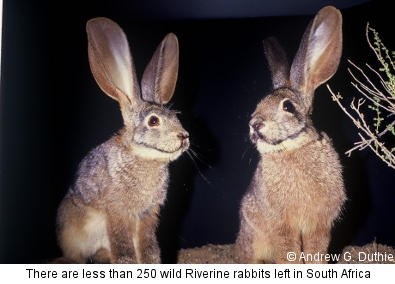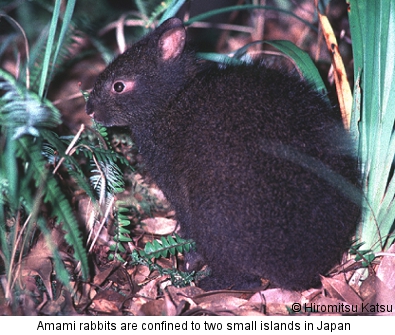Happy New Year! Today is the first day of the Chinese New Year and 2011 is the Year of the Rabbit.
In celebration of the Chinese year of the Rabbit, sales of cute and fluffy rabbits in China have risen and restaurants have seen increasing demand for rabbit based dishes. Amid the celebrations however, conservationists are using the Year of the Rabbit to highlight endangered and threatened rabbits, hares and pikas which all belong to the Lagomorph order.
1 in 4 species of rabbits, hares and pikas are listed on the IUCN Red List of Threatened Species and of these animals, 3 species of rabbit are featured in the Top 100 EDGE Mammals list that highlights unique species in urgent need of conservation.
The Riverine rabbit (Bunolagus monticularis) hops into the Top 100 at number 9. The population of this rabbit is thought to be less than 250 individuals! Found in just a few areas of the Karoo Desert, South Africa, much of the habitat in which it lived has been converted into farm-land. All of the remaining individuals are found on privately owned land where they are at further risk of hunting, trapping and predation from cats and dogs. Subsequently it is difficult to introduce conservation measures to benefit this species.
Snuffling its way into the Top 100 at number 40 is one of the smallest rabbit species, the Volcano rabbit (Romerolagus diazi). Found in small and scattered populations on the slopes of four volcanoes in central Mexico this rabbit is the only species in its genus making it one of the most evolutionarily distinct members of the Leporidae family. Despite a hunting ban and the establishment of protected areas connecting the rabbit populations, threats from habitat loss and hunting continue, partly because many local people are not aware that hunting of this species is illegal.
The Amami rabbit (Pentalagus furnessi) has burrowed itself into the number 45 position in the Top 100 EDGE mammals. This species has small eyes and ears with dense dark fur that makes it look less like the typical rabbit we all think of and shares more characteristics with fossil species from the Miocene period. Found only on two small islands in the south of Japan this species is primarily threatened by habitat loss caused by logging and road construction. The population of Amami rabbit was also devastated by the introduction of Java mongooses to the islands in a failed attempt to control the population venomous habu pit vipers.
All the rabbits, hares and pikas on the IUCN Red List of Threatened species are primarily threatened by habitat loss, over-hunting and disease. Rabbits can be key-stone species within their habitats and play an important role in maintaining the health of an ecosystem. For example rabbits can alter plant composition through grazing and seed dispersal and their digging can increase soil enrichment. Rabbits are also prey for a number of predators, some of which are endangered. Therefore conservation of these Lagomorphs will benefit the habitats in which they are found and the Year of the Rabbit is a prime opportunity in which to highlight the conservation they need.
If you would like to help Evolutionarily Distinct and Globally Endangered animals such as the Riverine, Volcano and Amami rabbits by supporting EDGE you can do so here.


